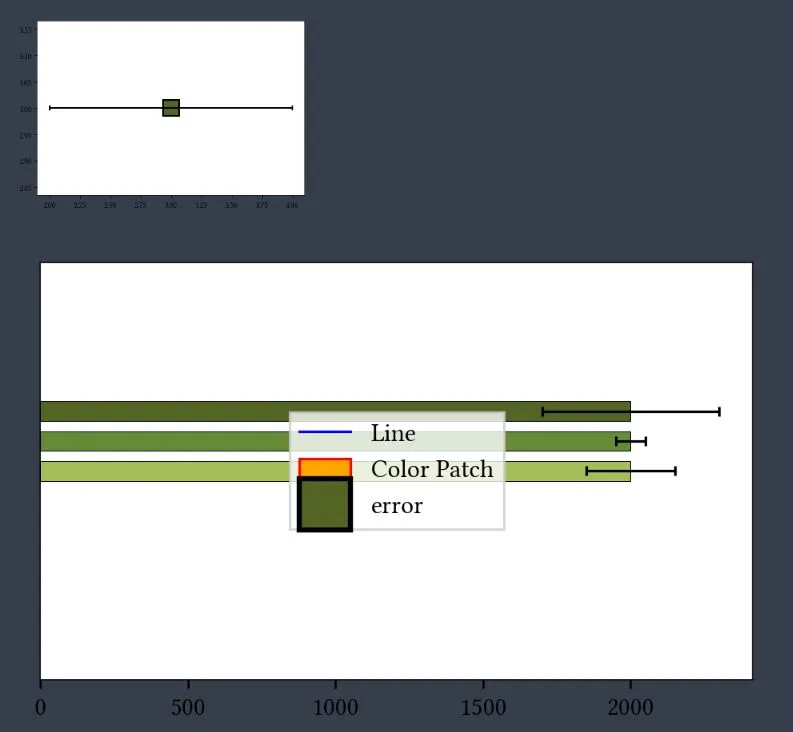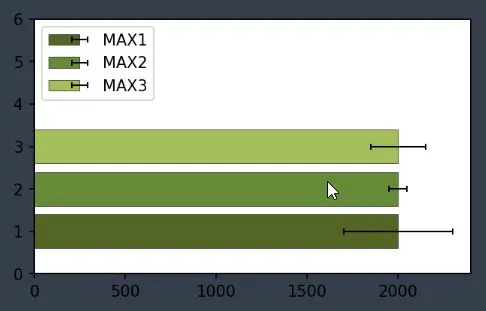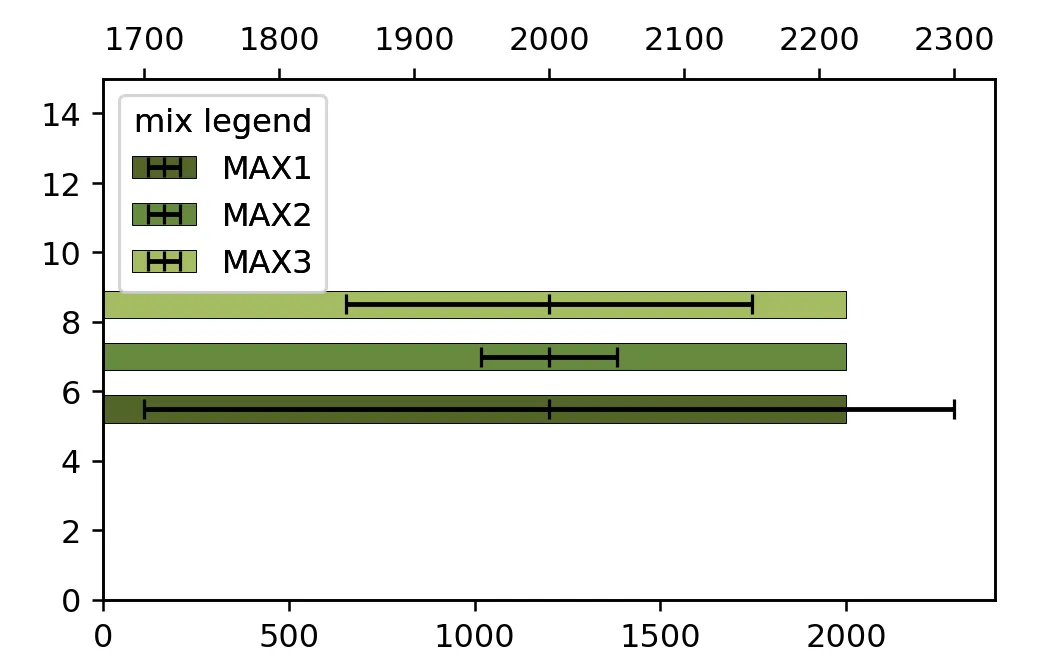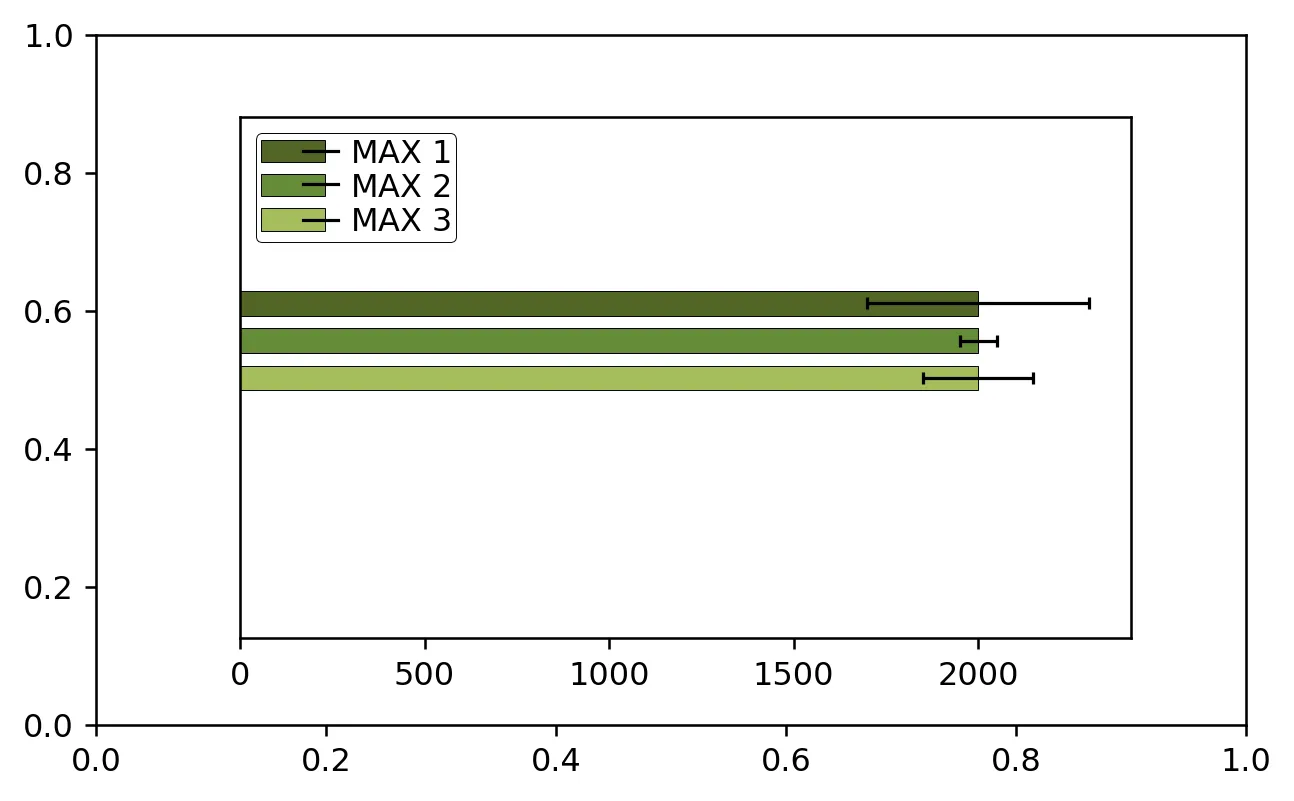是否可以在图例中显示误差条?
(就像我用红色绘制的那样)
它们不一定要是正确的长度,只要它们被指示并且可识别即可。
我的工作示例:
import pandas as pd
import matplotlib.pyplot as plt
test = pd.DataFrame(data={'one':2000,'two':300,'three':50,'four':150}, index=['MAX'])
fig, ax = plt.subplots(figsize=(5, 3), dpi=230)
ax.set_ylim(-.12,.03)
# barplot
ax = test.loc[['MAX'],['one']].plot(position=5.5,color=['xkcd:camo green'], xerr=test.loc[['MAX'],['two']].values.T, edgecolor='black',linewidth = 0.3, error_kw=dict(lw=1, capsize=2, capthick=1),ax=ax,kind='barh',width=.025)
ax = test.loc[['MAX'],['one']].plot(position=7,color=['xkcd:moss green'], xerr=test.loc[['MAX'],['three']].values.T, edgecolor='black',linewidth = 0.3, error_kw=dict(lw=1, capsize=2, capthick=1),ax=ax,kind='barh',width=.025)
ax = test.loc[['MAX'],['one']].plot(position=8.5,color=['xkcd:light olive green'],xerr=test.loc[['MAX'],['four']].values.T, edgecolor='black',linewidth = 0.3, error_kw=dict(lw=1, capsize=2, capthick=1),ax=ax,kind='barh',width=.025)
# Legende
h0, l0 = ax.get_legend_handles_labels()
l0 = [r'MAX $1$', r'MAX $2$', r'MAX $3$']
legend = plt.legend(h0, l0, borderpad=0.15,labelspacing=0.1, frameon=True, edgecolor="xkcd:black", ncol=1, loc='upper left',framealpha=1, facecolor='white')
legend.get_frame().set_linewidth(0.3)
cur_axes = plt.gca()
cur_axes.axes.get_yaxis().set_ticklabels([])
cur_axes.axes.get_yaxis().set_ticks([])
plt.show()
我尝试了几种方法,但都没有成功。使用legend_elements中的Patch函数无法获得误差条线条,使用errorbar()函数可以绘制带有误差条的图形,但似乎无法在图例中使用:
import pandas as pd
import matplotlib.pyplot as plt
from matplotlib.patches import Patch
from matplotlib.lines import Line2D
legend_elements = [
Line2D([1,2], [5,4], color='b', lw=1, label='Line'),
Patch(facecolor='orange', edgecolor='r', label='Color Patch'),
matplotlib.pyplot.errorbar(3, 3, yerr=None, xerr=1, marker='s',mfc='xkcd:camo green', mec='black',
ms=20, mew=2, fmt='-', ecolor="black", elinewidth=2, capsize=3,
barsabove=True, lolims=False, uplims=False, xlolims=False, xuplims=False,
errorevery=2, capthick=None, label="error"),
]
test = pd.DataFrame(data={'one':2000,'two':300,'three':50,'four':150}, index=['MAX'])
fig, ax = plt.subplots(figsize=(5, 3), dpi=230)
ax.set_ylim(-.12,.03)
# barplot
ax = test.loc[['MAX'],['one']].plot(position=5.5,color=['xkcd:camo green'], xerr=test.loc[['MAX'],['two']].values.T, edgecolor='black',linewidth = 0.3, error_kw=dict(lw=1, capsize=2, capthick=1),ax=ax,kind='barh',width=.025)
ax = test.loc[['MAX'],['one']].plot(position=7,color=['xkcd:moss green'], xerr=test.loc[['MAX'],['three']].values.T, edgecolor='black',linewidth = 0.3, error_kw=dict(lw=1, capsize=2, capthick=1),ax=ax,kind='barh',width=.025)
ax = test.loc[['MAX'],['one']].plot(position=8.5,color=['xkcd:light olive green'],xerr=test.loc[['MAX'],['four']].values.T, edgecolor='black',linewidth = 0.3, error_kw=dict(lw=1, capsize=2, capthick=1),ax=ax,kind='barh',width=.025)
# Legende
h0, l0 = ax.get_legend_handles_labels()
l0 = [r'MAX $1$', r'MAX $2$', r'MAX $3$']
legend = plt.legend(h0, l0, borderpad=0.15,labelspacing=0.1, frameon=True, edgecolor="xkcd:black", ncol=1, loc='upper left',framealpha=1, facecolor='white')
legend.get_frame().set_linewidth(0.3)
ax.legend(handles=legend_elements, loc='center')
cur_axes = plt.gca()
cur_axes.axes.get_yaxis().set_ticklabels([])
cur_axes.axes.get_yaxis().set_ticks([])
#plt.show()
import pandas as pd
import matplotlib.pyplot as plt
test = pd.DataFrame(data={'one':2000,'two':300,'three':50,'four':150}, index=['MAX'])
fig, ax = plt.subplots(figsize=(5, 3), dpi=150)
ax.set_ylim(0, 6)
ax.set_xlim(0, 2400)
ax1 = ax.twiny()
ax1.set_xlim(0, 2400)
ax1.set_xticks([])
ax.barh(1, width=test['one'], color=['xkcd:camo green'], edgecolor='black',linewidth = 0.3, label='MAX1')
ax.barh(2, width=test['one'], color=['xkcd:moss green'], edgecolor='black',linewidth = 0.3, label='MAX2')
ax.barh(3, width=test['one'], color=['xkcd:light olive green'], edgecolor='black',linewidth = 0.3, label='MAX3')
ax1.errorbar(test['one'], 1, xerr=test['two'], color='k', ecolor='k', fmt=',', lw=1, capsize=2, capthick=1, label='MAX1')
ax1.errorbar(test['one'], 2, xerr=test['three'], color='k', ecolor='k', fmt=',', lw=1, capsize=2, capthick=1, label='MAX2')
ax1.errorbar(test['one'], 3, xerr=test['four'], color='k', ecolor='k', fmt=',', lw=1, capsize=2, capthick=1, label='MAX3')
handler, label = ax.get_legend_handles_labels()
handler1, label1 = ax1.get_legend_handles_labels()
label1 = ['' for l in label1]
ax.legend(handler, label, loc='upper left', handletextpad=1.5)
ax1.legend(handler1, label1, loc='upper left', handletextpad=1., markerfirst=False, framealpha=0.001)
plt.show()
变更:
ax1获得与ax相同的限制- 删除所有来自
label1的字符串 - 在
ax1.legend()中,处理程序和标签的顺序被交换,并且使用handlertextpad将误差线向右移动




